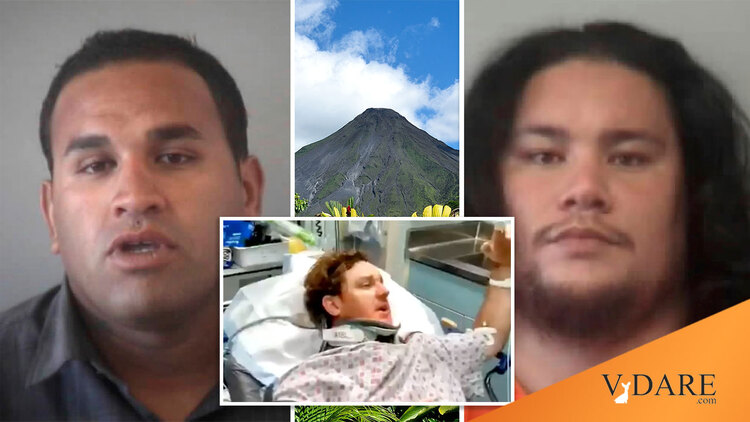


By Steve Sailer
03/06/2023
From the Associated Press:
A hate crime lays bare Hawaii’s complicated race relations
By JENNIFER SINCO KELLEHER
March 2, 2023HONOLULU (AP) — Two Native Hawaiian men wouldn’t have brutally beaten a man if he weren’t white, a U.S. judge said Thursday in sentencing them to yearslong prison terms for a hate crime in a case that reflects Hawaii’s nuanced and complicated relationship with race.
A jury convicted Kaulana Alo-Kaonohi and Levi Aki Jr. in November, finding that they were motivated by Christopher Kunzelman’s race when they punched, kicked and used a shovel to beat him in 2014. His injuries included a concussion, two broken ribs and head trauma.
Local lawyers believe this is the first time the U.S. has prosecuted Native Hawaiians for hate crimes.
No explanation is offered in the article for why the feds subjected the perps to double jeopardy. Perhaps it’s become one of the attackers got off with only probation in an earlier state trial.
The unique case highlights the struggles between Native Hawaiians who are adamant about not having their culture erased and people who move to Hawaii without knowing or considering its history and racial dynamics. …
Kunzelman and his wife purchased the house sight-unseen for $175,000 because she wanted to leave Scottsdale, Arizona, to live near the ocean after being diagnosed with multiple sclerosis. …
“It was obviously a hate crime from the very beginning,” she said. “The whole time they’re saying things like, ‘You have the wrong skin color. No ‘haole’ is ever going to live in our neighborhood.’”
“Haole,” a Hawaiian word with meanings that include foreigner and white person, is central to the case. It’s a word often misunderstood by people who don’t comprehend Hawaii’s history of U.S. colonization and the 1893 overthrow of the Hawaiian Kingdom by a group of American businessmen, said Judy Rohrer, author of a book titled “Haoles in Hawai’i.”
White people who move to Hawaii are unaccustomed to being identified racially and are “not used to thinking about whiteness,” said Rohrer, who grew up white in Hawaii and is now a professor at Eastern Washington University. “We’re used to being in the majority and then we get to Hawaii and all of a sudden we’re not in the majority, and that makes us uncomfortable.”
White people in Hawaii are especially uncomfortable while being subjected to concussions.
Of Hawaii’s 1.5 million residents, about 38% are Asian, 26% are white, 2% are Black, and many people are multiple ethnicities, according to U.S. census figures. Native Hawaiians account for about 20% of the population.
But it’s more than racial, Rohrer said, explaining how the Hawaiian word has become part of Hawaii Pidgin, the creole language of the islands, to describe behavior or attitudes not in sync with local culture.
“Acting haole” means “acting out of entitlement, and like you own the place,” she said.
Kunzelman did own the place where he was attacked.
In video recorded by cameras on Kunzelman’s vehicle parked under the house, only one racial utterance can be heard, defense attorneys said. Aki is heard saying, “You’s a haole, eh.” …
After the assault, Aki referred to Kunzelman to police as a “rich Haole guy,” a “dumb haole,” and a “typical haole thinking he owning everything … trying to change things up in Kahakuloa,” prosecutors said.
Tiare Lawrence, a Native Hawaiian community advocate on Maui, said she doesn’t condone the attack but is deeply familiar with the tensions that permeate the case.
“The threat of outsiders coming in … brings a lot of sadness for Hawaiians who are trying so hard to hold on to what little piece of paradise we have left,” she said.
The existence of anti-white racist violence in Hawaii is hardly unknown. For example, in my 2018 review of New Yorker writer William Finnegan’s surfing memoir Barbarian Days (which, David Pinsen pointed out I should have named “Finnegans Wave”), I wrote that when his family moved from Los Angeles to Honolulu in the 1960s:
Being familiar only with the fine Los Angeles public schools of that long-ago era, his parents blithely dumped him in a Honolulu public junior high, where Kill Haole Day was every day. Fortunately, Finnegan found refuge in a white gang. …
While some of Finnegan’s Honolulu surf buddies were Native Hawaiian or Japanese, the only African-American who appears in the book is Punahou Prep’s nonsurfing Barack Obama, who is amazed to hear in 2004 that Finnegan’s parents had sent him to a notoriously haole-hostile public school.